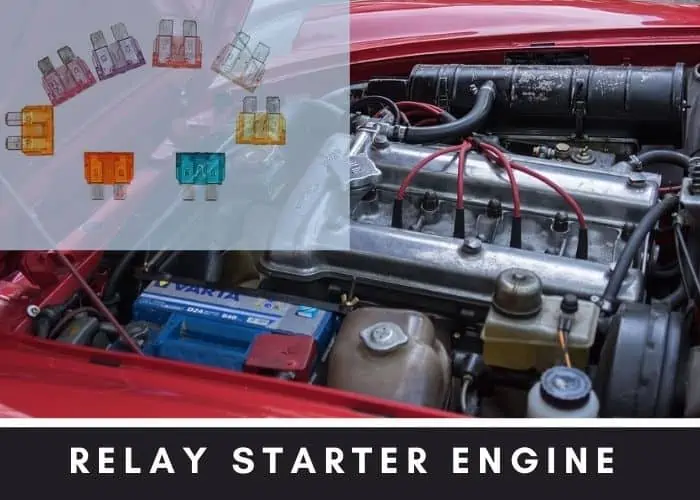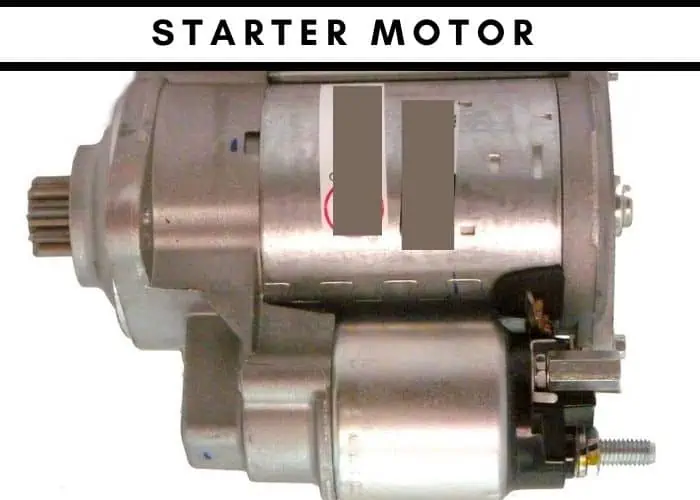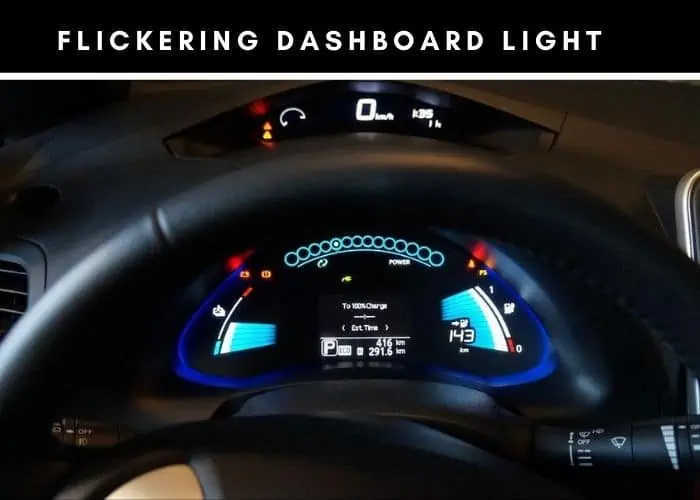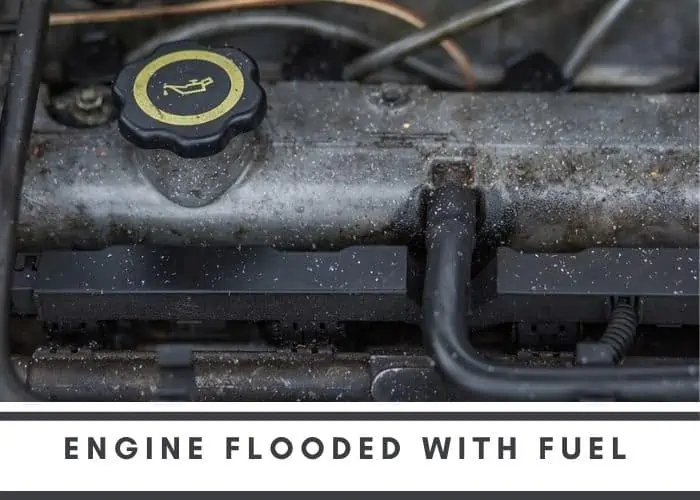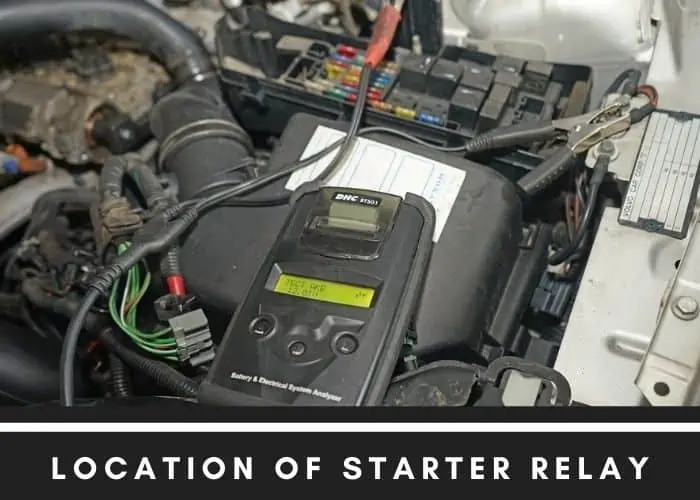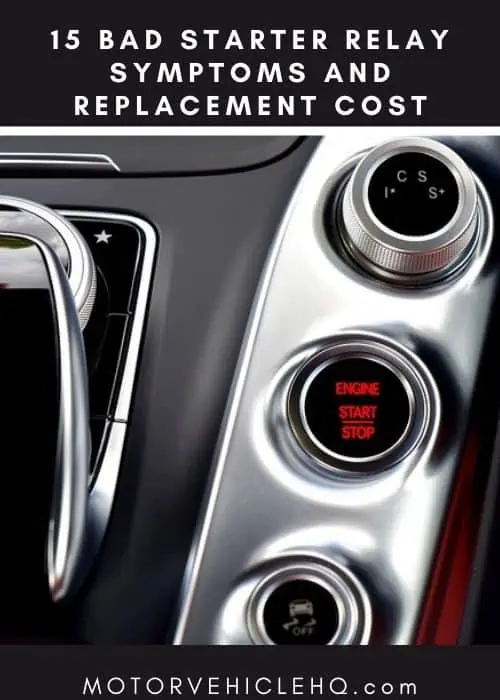A bad starter relay can cause many problems, starting with the car battery not charging and leading to the vehicle not starting. A starter relay sends the required voltage from a car battery to the starter motor that starts the engine when you turn the ignition key.
Learning to identify bad starter relay symptoms will save you a lot of time. It can be an expensive part, but it is also easy to test and diagnose by yourself if you are technically inclined.
Relay starter engines are a type of engine that uses a relay to connect the battery to the solenoid. The solenoid is what causes the engine to start running. The relay receives power from the battery and sends it to the solenoid, which in turn starts up your car’s engine.
What Is a Starter Relay in a Car
A starter relay is a device that activates the starter motor in your vehicle. You’ll find it in the engine compartment, near the battery.
You can identify the starter relay by its size and shape (it’s usually a large box with two or more wires coming out of it) and its function (it powers up the starter motor when you press your car’s ignition button).
The starter relay receives power from your car’s battery via a wire that runs from the battery to a post on the relay.
It sends an electrical signal to the starter relay when you press your car’s ignition button, which activates the starter motor by sending power through another wire to the solenoid in your engine bay.
The solenoid then opens up and allows current to flow through it, starting up your engine by turning over its pistons.
To replace a starter motor, you’ll need to remove the old one and replace it with a new one. You might also need to replace some other parts for them to work together (such as a relay), but that depends on your car’s make and model.
Starter relays are necessary for most cars’ engines because they can handle more power than any individual component in your engine bay could—they allow you to start your vehicle with ease.
Below, we present some common starter relay symptoms that indicate it’s time to change your starter relay or get it checked by a mechanic.
#1. Car Won’t Start But Lights Work
If your car doesn’t start, but the lights work, it could be a few things. If you’ve got an older model vehicle, the problem may be corrosion on the battery terminals or in the starter relay (aka starter solenoid).
Clean these areas with a wire brush and check for any frayed wires or damaged connectors.
If you’re having problems after that, try replacing your battery terminal clamps and checking all of your fuses and relays. If those don’t fix it, it’s time to call someone who knows what to do.
#2. The Starter Turns but the Engine Won’t Turn Over
If you’ve determined that the starter relay is not engaging, one of two things is likely happening. Either the relay is not receiving power, or it’s simply not working.
If your vehicle has lost power to the headlights and electrical components, but your starter battery turns without assistance, you may have a dead battery and should replace it immediately.
In this case, there is nothing wrong with the starter or its wiring connections to your vehicle’s electrical system.
If you can’t turn over your car because of failure in the starting system itself — for example, if there are no headlights or gauges sending power when started — you will need to replace a major component, such as an alternator.
If you have an intermittent problem with your starter relay, it could cause flickering dashboard lights. You can test this by unplugging the wire harness from the relay and connecting it to another post on the battery or positive terminal.
#3. A Flickering Dashboard Light
A flickering dashboard light can be a sign of a faulty starter relay. If you aren’t sure what the problem is, take your vehicle to an experienced mechanic who will diagnose the issue and fix it at a reasonable price.
A faulty starter relay can cause issues with your car’s electrical system. For example, if one of the wires in your car has come loose or broken off, it could short out against another wire and cause damage to both components. That’s why it’s crucial to repair any damage as soon as possible.
#4. Jumpstarting the Vehicle
If the vehicle battery is the problem, you can jump-start the car with a good battery. You can do this with or without jumper cables.
- To jump-start your vehicle, locate the starter motor on both vehicles and place them in park position or neutral on each side of the dead car engine block (usually located just under where your hood meets your fender).
- Connect one end of a jumper cable to each positive (+) terminal on both batteries. Ensure that clamps are secure before connecting them to prevent sparks from flying when you turn over your engine. A quick way to check this is by using a voltmeter connected between those two terminals; if it reads 12 volts or more, you’re all set.
#5. The Positive Battery Cable Is Failing
The positive battery cable is the one that connects the battery to the starter. It’s responsible for delivering a burst of current when you turn your key, sending power from that big box under your hood to spin up your engine.
As such, it’s also the most common cause for a starter not working. To test if your positive battery cable is faulty, grab a multimeter and check it with these steps:
- Turn off your vehicle.
- Set a multimeter on the DC volts (V) setting.
- Touch black lead of the meter to the negative (-) terminal on the battery and red lead on the other end of the positive (+) terminal of the battery.
#6. Dashboard Light Does Not Turn On
The starter relay is faulty if your vehicle’s dashboard light does not turn on. It can be due to a failed internal component or a loose connection in the wiring harness. Replacing the faulty relay should be relatively simple and inexpensive.
#7. Engine Does Not Crank Over
If your car does not start when you turn the key, check to see if there is power going to this area. If there is no power, try checking for any blown fuses or loose connections in the system. Check to see if these are all good, you may need to replace your starter relay.
#8. Starter Works Intermittently
When a starter relay is faulty, it may cause the engine to start and then stop. It can happen at any time and is unexpected. Another symptom is if the engine starts and then stalls when driving.
When this happens, you will need to wait several minutes or even an hour before trying again because it could be a bad starter relay sign that needs replacement.
Another symptom of a faulty starter relay is when the engine starts but abruptly dies after starting up.
It happens because there’s not enough juice flowing through the battery or alternator due to faulty starter relays failing at sending voltage from one of these items into your car’s electrical system.
A flooded engine is when it has too much fuel in it. It can happen when you have a bad connection between your ignition coil and spark plug.
#9. Engine Is Flooded With Fuel
If your vehicle is flooded with fuel, the starter relay has likely failed. The engine will continue to run after you turn off the ignition switch.
It can be hard to diagnose a faulty starter relay because it may not cause any other symptoms in the vehicle.
However, once you replace the relay and put everything back together again, you should notice an improved engine performance and fuel economy.
#10. Car Makes a Clicking Sound but Does Not Start
If you hear a clicking sound when you turn the key, this could be a faulty relay. To test this theory, try unplugging the relay and see if your car starts. If it does, then it’s time to replace that bad boy.
Start by checking the battery itself: Does it have enough power? Next, check whether your starter is working by listening for any sounds during operation or trying to manually move it with a wrench on its cable (if possible).
Also, double-check that all wiring is securely connected and functioning.
If those tests come out negative, but you still think there might be something wrong with your starter relay — or if they do come back positive — then start troubleshooting from there.
#11. Car Starts When the Key Is Turned Backward
This is a common symptom. When you locate the starter relay in the ignition switch and turn your key backward, it’s bypassed.
This can happen for many reasons, including:
- The starter relay is bad, and you need to replace it. Auto dealerships or independent mechanics can do this but will cost around $100-200, depending on how much labor is required to get it out from under there.
- Your ignition switch itself may be bad, and you should replace it (this costs about $150). You do not need an expert mechanic for this part, as you can easily do it yourself with patience and research online first.
#12. Starter Engages but the Ignition Does Not Turn On
If you get a clicking sound from the starter, but the ignition does not turn on, your starter relay is likely faulty.
The starter relay is a simple circuit that controls the flow of electricity to the starter and ignition coil. The relay is under the hood in front of the battery, and you access it by removing its cover.
The solenoid end of this relay goes into contact with terminal #56 on your vehicle’s firewall, coming from the fuse box (which supplies power to it).
When you try to start your car, this causes a heavy load on the starter relay; if the starter relay is not working, it may send too much or too little current to the starter solenoid and cause problems like dimming headlights or no power at all.
#13. Headlights Dim When You Try To Start the Car
If your headlights dim when you attempt to start the car, the following could be the cause:
- Low battery voltage. A faulty battery or a low charge in your battery can cause this issue.
- Faulty starter relay. If your starter relay is bad, it may not allow enough current for your vehicle’s electrical system to power. It will make it difficult for your starter motor to turn over when you turn the ignition key to start your engine.
- Faulty alternator/generator. If you have a problem with this component, it may not provide adequate energy while starting up and running parts, such as headlights or interior lights.
#14. Radio Turns On but the Engine Doesn’t Work
When your car radio turns on, but the engine won’t start, it’s probably because the starter relay has a problem.
Simply follow these steps:
- Turn on the ignition and make sure all your lights are working. If they aren’t, check the fuse box or replace any fuses that may be blown.
- Check to see if any of your dash lights are flickering or staying on permanently; this could be a sign that a bulb isn’t working correctly and you need to replace them immediately before it causes further damage to your vehicle’s electrical system.
- If everything seems to be working, it may be time for you to replace your starter relay.
#15. Alternator Charges but the Battery Drains Out Quickly
If you discover that the alternator charges, but the battery drains out quickly, there could be many reasons. Here are some things to check:
- Check the alternator and ensure it is working. The easiest way to do this is by checking for voltage at its terminals with a multimeter, but there are other methods.
- Check for loose or corroded battery cables, especially if you recently drove your car during bad weather conditions like rain or snow when corrosion can form on these surfaces. Wipe them clean with an anti-corrosion solution and apply petroleum jelly between them and their connectors (if possible) to prevent further corrosion until you have time to replace them. Ensure that all cable connections are tight.
- Tug on each cable at least once per week for about 15 seconds after installing new batteries to prevent premature wear caused by movement within those clips/connectors over time due to not having done so previously — especially if they’re old ones where there might be rust buildup inside them.
Replacement Cost of a Faulty Starter Relay
The replacement cost of a faulty starter relay is about $50 to $75. The starter relay is a crucial component in the car ignition system. When this relay fails, it can be very time-consuming to replace.
If you’re not confident about how to replace one of those, have no fear! It’s a pretty doable DIY job.
As long as you have some basic mechanical skills and the right tools, it’s an inexpensive repair to make yourself and get your car back on the road quickly. Follow the steps below to replace the faulty starter relay.
Look in the engine compartment to find the starter relay on your car. You can locate it near the battery.
How To Replace a Faulty Starter Relay
The First Step in Replacing a Faulty Starter Relay Is To Locate It
The first step in replacing a faulty starter relay is to locate it. In most vehicles, this will involve searching through the engine compartment and looking for one of the following:
- A fuse box;
- A relay box;
- A battery box;
- A starter box.
Once you find your way to the right spot, you’ll need to open up your hood and check out these items individually.
If you’re lucky enough to find the correct type of solenoid — where there’s a small lever or button on top with some label underneath it — then congratulations! That’s what you’re looking for today.
Pull the Starter Relay Out of the Box
- Remove the cover from the starter relay box. You will find it by tracing the wires connected from your car’s battery to a small box.
- Pull the starter relay out of its housing, and check it for damage. If there is any corrosion or other signs of wear and tear on this part, replace it with a new one before putting everything back together again.
- Reinstall the cover onto your starter relay box, and admire how much easier starting up your car will be now that you’ve replaced its faulty part.
Replace the Cover Over the Fuse Box
Now that you’ve removed the faulty starter relay and replaced it with a new one, it’s time to put everything back together.
- Replace the cover over the fuse box, ensuring not to leave any wires to lose or damage.
- Reattach all of your electrical wires where they go on the starter relay. Make sure you don’t accidentally expose any of them by putting them somewhere they shouldn’t be.
Turn the Key Back to the On Position and Then Turn It Back Over
To test the starter relay, turn the ignition to the on position. Then, turn it back over (to the off position).
If your vehicle starts and operates normally, you have found a problem with one of your other parts.
If your vehicle does not start or operate normally after turning it over in this way, then you will need to take your vehicle to a professional mechanic.
Replacing a Starter Relay Yourself Is Cheaper Than Paying a Mechanic
While it may seem like this is a simple enough task to do yourself, there are still some things you should consider before deciding what action to take.
- Cost: The starter relay costs $75, while the replacement at a mechanic will cost around $150. If you buy your starter relay and replace it yourself, you’ll save $75.
- Time: It takes about 20 minutes or less for someone with basic skills and tools to replace their starter relay versus over an hour at a mechanic shop.
- Experience: If you have no prior experience working on cars or other vehicles, we recommend having someone else do it for you unless they are willing to teach you how first.
Conclusion
It’s crucial to identify signs of wear and tear on your car for safety reasons and keep it in top working order. By keeping this post handy and familiarizing yourself with the most common starter relay symptoms, you can save yourself a lot of money due to preventative maintenance.
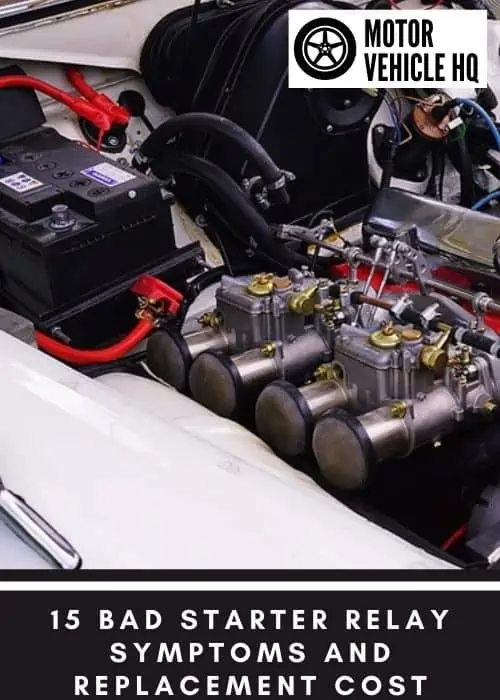

Jim Wicks is the founder of MotorVehicleHQ. With over two decades of experience in the automotive industry and a degree in Automotive Technology, Jim is a certified car expert who has worked in various roles ranging from a mechanic, car dealership manager, to a racing car driver. He has owned more than 20 cars over the past 15 years. Ask him about any vehicle you see on the road and he can tell you the make, model and year. He loves the aesthetics of all things cars, and keeps his vehicles in pristine condition.
In his free time, Jim enjoys getting his hands dirty under the hood of a classic car or taking long drives along the country roads. His favorite car? A 1967 Shelby GT500, a true classic that, according to Jim, “represents the pure essence of American muscle.”
